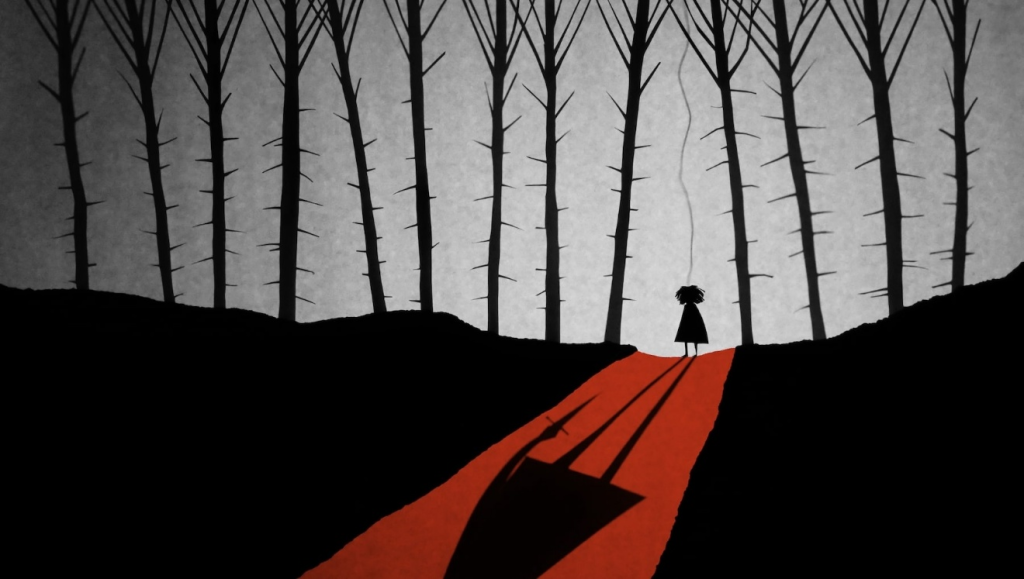
Cal Performances presents The 4th Witch, November 22, 2025 at Zellerbach Hall
(credit: Courtesy of Manual Cinema)
Witching Hour
The 4th Witch
Manual Cinema
Zellerbach Hall
University of California, Berkeley
Reviewed by Christopher Bernard
For (frustratingly) one lonely, tantalizing performance, Cal Performances, in co-commission and as part of its “Illuminations: Exile and Sanctuary” series, brought the bright good witches of Chicago’s Manual Cinema on a recent Saturday evening for a brew of witchery and magic that they, and they alone, are (in this apprentice wizard’s experience, anyway) uniquely qualified to provide.
I say frustratingly because I can’t understand how this company’s brilliant toilers, who spent a year creating a compact music-filled masterpiece of puppetry, handicraft, cinema and wonder, can’t have been given a full weekend among us: the hall was packed, riveted to marvels of stagecraft and story-telling, without a pixel or a bow to “slop” in sight, and few left for the fascinated Q&A that followed. When something this fine, brave, and wondrous blazes across the Bay Area’s sky like a comet blithely visiting from a neighboring universe, one can hardly settle for a single, dazzling show – no!
It’s not as if the company were new here and on probation: they brought us a scintillating Ada/Ava in the millennium before Covid (circa 2017, to be precise). The 4th Witch is even finer, and marks one of the peaks in Bay Area performance since then. For those new to Manual Cinema, a brief description may be in order. The creative heart of the company is given to inventing live performances of puppetry, hand-crafted backgrounds, body prostheses, and props and the techniques of shadow plays projected onto large screens and accompanied by live music.
One of the most intriguing aspects of the performance is that, rather than seeing only the end result onscreen, we also see, in the background onstage, the combined actions of actors, puppets, prop managers, projectors, and musicians as they bring the final result about. It’s a bit like a combination of Bunraku puppeteering and an open kitchen at a small five-star restaurant. Far from undermining the magic, it paradoxically makes the end result seem like pure alchemy, as the mind is cast into the liminal space between the quotidian reality and the magical effect. The result is a profoundly poetic form of animation that has the high-wire thrills of live performance.
The premise of Saturday’s show is as beautiful in its simplicity as it is timely without being brow-beating. As described by one of the members in the Q&A, they took a page from Tom Stoppard’s famous play from the 1960s, Rosencrantz and Guildenstern Are Dead, which retells the story of Hamlet through the eyes of his half-clueless, half-traitorous school fellows, and reimagined another famous play by the Bard – in this case, Macbeth , though, in keeping with sacred theatrical tradition, the tragedy is referred to onstage only as “the Scottish play”– from the point of view of one of the Thane of Cawdor’s victims.
The story is updated to an imaginary, mid-twentieth-century war in a French-speaking country, and the victim is a young girl whose parents run a little restaurant in a town piled up a steep, isolated hill, much like Mont-Saint-Michel on the Normandy coast of France. The girl’s parents are killed in a raid by Macbeth’s air force. The town is left in ruins, and she runs away after a futile attempt to bring down the mocking, glow-eyed, gas-masked, Darth Vader-like Macbeth by striking him with her stuffed bunny rabbit, her sole possession saved from the wreckage of her home.
Lost in the surrounding forest, wandering for days, reduced to hunger and rags, she discovers a mysterious house, where she is met by a sinister old woman who takes her in and sets her to work. The old lady turns out, naturally, to be a witch – indeed, she is one of three, magically embodied in the one, who have a mysterious relation to Macbeth and his powers, a relation that shall not be revealed here, for those seeking spoilers. After the girl, taking a sip of a spell-casting soup, has a sorcerer’s apprentice moment in the witch’s kitchen, the old one decides to teach her witches’ ways – a fourth to add to the three.
And the powers in magic that the girl gains – black as the night, from making magic potions from mushrooms of the forest, to night flying on broomsticks, to commanding daggers to fly to the hearts of their victims – feed the dreams she cultivates of revenge against the murderer of her parents. We’ll leave it at that.
Whoever knows “the Scottish play” can guess much, but not everything: not how famous elements of the play – from floating daggers to the bitter washing of hands, from the assassinations of kings to the executions of assassins – are mixed and blended, with imagination and wit, nor how the amalgam of the imaginary, the remembered, and the hoped for is finally annealed into a satisfying whole – a Gesamtkunstwerk (forgive my German) held light and bright, from acting as rich as a puppet’s to puppetry as nuanced as a great actor’s, to potently low-tech sound design and music from a trio of instrumentalists seconding as vocalists, to world-creating as lyrical and witty as it is suggestive of its own self-contained universe.
Play on, Manual Cinema! And blessed be those Who bring ye back for more than one more show!
Christopher Bernard is an award-winning poet, novelist, playwright, and essayist. His most recent book is The Beauty of Matter: A Pagan’s Verses for a Mystic Idler. 2025 is the twentieth anniversary of the publication of his celebrated debut novel, A Spy in the Ruins.
